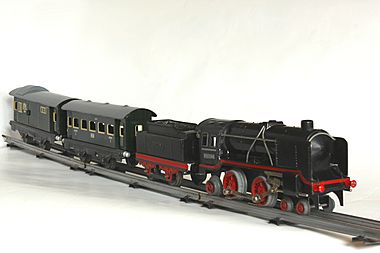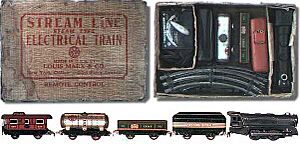Toy train facts for kids
A toy train is a toy that looks like a real train. It's different from a model train because toy trains are usually cheaper and tougher. They are made for playing, not for being super accurate. A toy train can be very simple, like a pull toy that doesn't even need tracks. Others might run on clockwork (like a wind-up toy) or use a battery. Some modern model trains can also be seen as toy trains if they are strong enough for kids to play with.
Contents
What is a Toy Train?
A toy train is simply a smaller version of a train made for kids to play with. Some toy trains are even big enough for children to ride on. These can run on tracks or sometimes even without them.
Toy Trains for Everyone
The term "toy train" can sometimes mean more than just toys for kids. For example, in India, some real trains that run on narrow tracks are called toy trains. The Darjeeling Himalayan Railway is one of these. Even though adults ride it, people still call it a toy train.
Toy Trains vs. Model Trains
The term "toy train" is usually not used for very detailed train models. These are often collected by adults as a serious hobby. Because they look so real, they are called "model trains" instead.
How Toy Trains Are Measured
The first common ways to measure toy trains were set up in Leipzig, Germany. This happened in 1891 thanks to a company called Märklin.
Train Track Sizes
Train tracks are measured by their "gauge." This is the distance between the rails. Märklin measured the distance between the centers of the two outer rails. Here are some of the early sizes:
| Name | Width (metric/imperial) (centers of outer rails) |
Size (Scale) | Notes |
|---|---|---|---|
| Number 5 gauge | 120 mm or 4.72 in | 1:8 | Also known as V (Roman numeral for five) |
| Number 4 gauge | 75 mm or 2.95 in | 1:11 or 1:20 | Also known as IV (four) or 3 gauge. |
| Number 3 gauge | 67 mm or 2.64 in | 1:16 or 1:22 or 1:23 | Also known as III, II, IIa gauges. |
| Number 2 gauge | 54 mm or 2.13 in | 1:22.5 or 1:27 or 1:28 | Also known as II gauge. |
| Number 1 gauge | 45 mm or 1.77 in | 1:32 or 1:30 | Also known as I gauge. Used by modern G scale. |
| Number 0 gauge | 35 mm or 1.38 in | 1:48 or 1:43 or 1:45 or 1:64 | Started around 1900. This is similar to modern O gauge (32 mm or 1.26 in track gauge). |
USA Train Sizes
Here are some common train sizes (gauges) used in the USA, from smallest to largest:
- Z Gauge [1:220]
- N Gauge [1:160]
- HO Gauge [1:87]
- S Gauge [1:64]
- O Gauge [1:43 to 1:48, varies]
- G Gauge [1:20]
Why Sizes Can Be Different
Sometimes, companies like Lionel might have misunderstood Märklin's rules. This led to different sizes for the same gauge, like with O gauge trains in the United States and Europe. Many of these early large sizes were not very popular. They were too big for inside homes and cost a lot to make.
Popular Toy Train Sizes Today
Today, some larger trains like Wide gauge (similar to 2 gauge), 1 gauge, and O gauge are still made. Of these, O gauge is the most popular for toy trains.
Modern toy train sizes also include S gauge, HO scale, N scale, and Z scale. These are listed from largest to smallest. HO and N scale are very popular for model railway hobbies. However, cheaper sets sold in toy stores are less realistic than those for serious collectors. O gauge is still a top choice for toy trains.
Building Trains with Lego
Another fun way to have toy trains is by building them with Lego. These are called L gauge trains. They are roughly 1/38 the size of real trains.
Wooden Toy Trains
Many companies make wooden toy trains that run on wooden tracks. These are often called "Brio" or "Thomas" compatible. This is because Brio and Thomas & Friends are two big companies that make them. These tracks don't have metal rails. Instead, they have grooves for the train wheels. Other systems like Plarail from Tomy and Trackmaster use a similar idea. While trains from different brands might fit on each other's tracks, they might not work perfectly on all curves or special pieces.
Playmobil Trains
Playmobil also makes train systems as part of their toy worlds. They have two main types. One is for older kids, with electric trains and remote controls. These tracks are strong enough to be used outside, like a garden train. The other system is for younger children or toddlers.
Trains for Very Young Kids
Companies like "Wader Toys" make train systems for very young kids. These sets include tracks for roads, rails, and even water. The pieces are simple, strong, and can be washed. They are designed to be safe, with no sharp edges or small parts that could be a choking hazard. For these toys, looking exactly like a real train is less important than being safe and fun.
Scale vs. Gauge
The words "scale" and "gauge" are often used as if they mean the same thing. But they are a bit different. "Gauge" is the distance between the rails. "Scale" is how much smaller the model is compared to the real thing (like 1:48 means 1 unit on the model is 48 units in real life).
Different Scales for O Gauge
Many toy train makers didn't worry too much about perfect scale. American Flyer was one company that tried to be more accurate. "O scale" and "S scale" usually mean very accurate models. "O gauge" and "S gauge" often refer to toy trains made by companies like Lionel and American Flyer. While S gauge is pretty consistent at 1:64 scale, O gauge trains can be many different sizes.
O gauge track is about 1/45 the size of real train tracks. So, European makers often used 1:45 for O gauge trains. British makers rounded this to 1:43. U.S. makers rounded it down to 1:48. However, many companies made their trains a bit smaller than true scale. This was to make them fit better in smaller spaces. Some even made 1:64 scale trains (which is the right size for S gauge) to run on O gauge tracks, especially for cheaper sets.
Early O Gauge Trains
Some of the very first O gauge trains were made of tin. They didn't look realistic at all. They were short like modern HO scale trains, but much wider and taller.
Collecting and Playing
Some adults who love toy trains enjoy running them. Others just like to collect them. Some toy train layouts try to look very real, with tiny buildings and cars. Others use toy buildings and figures. Some collectors only buy accessories from the same company that made their trains. This is common for fans of Marx and Lionel trains.



